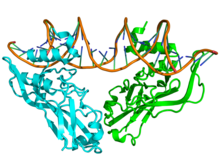T-box
| T-box | |||||||||||
|---|---|---|---|---|---|---|---|---|---|---|---|
 Crystallographic structure of the TBX3 protein dimer (cyan and green) complexed with DNA (brown) based on the PDB: 1h6f coordinates. | |||||||||||
| Identifiers | |||||||||||
| Symbol | T-box | ||||||||||
| Pfam | PF00907 | ||||||||||
| InterPro | IPR001699 | ||||||||||
| PROSITE | PS50252 | ||||||||||
| SCOP2 | 1xbr / SCOPe / SUPFAM | ||||||||||
| |||||||||||
T-box refers to a group of transcription factors involved in limb and heart development.[1]
In humans and some other animals, defects in the TBX5 gene expression can lead to finger-like thumbs and ventricular septal defects in which there is no separation between the left and right ventricle of the heart and are responsible for Holt-Oram syndrome.
The encoded proteins of Tbx5 and Tbx4 play a role in limb development, and play a major role in limb bud initiation specifically.[2] For instance, in chickens Tbx4 specifies hindlimb status while Tbx5 specifies forelimb status.[3] The activation of these proteins by Hox genes initiates signaling cascades that involve the Wnt signaling pathway and FGF signals in limb buds.[2] Ultimately, Tbx4 and Tbx5 lead to the development of apical ectodermal ridge (AER) and zone of polarizing activity (ZPA) signaling centers in the developing limb bud, which specify the orientation growth of the developing limb.[2] Together, Tbx5 and Tbx4 play a role in patterning the soft tissues (muscles and tendons) of the musculoskeletal system.[4]
TBX3 is associated with ulnar-mammary syndrome in humans, but is also responsible for the presence or absence of dun color in horses, and has no deleterious effects whether expressed or not.[5]
Genes encoding T-box proteins include:
See also
References
- ^ Wilson V, Conlon FL (2002). "The T-box family". Genome Biology. 3 (6): REVIEWS3008. doi:10.1186/gb-2002-3-6-reviews3008. PMC 139375. PMID 12093383.
{{cite journal}}: CS1 maint: unflagged free DOI (link) - ^ a b c Tickle C (October 2015). "How the embryo makes a limb: determination, polarity and identity". Journal of Anatomy. 227 (4): 418–30. doi:10.1111/joa.12361. PMC 4580101. PMID 26249743.
- ^ Rodriguez-Esteban C, Tsukui T, Yonei S, Magallon J, Tamura K, Izpisua Belmonte JC (April 1999). "The T-box genes Tbx4 and Tbx5 regulate limb outgrowth and identity". Nature. 398 (6730): 814–8. doi:10.1038/19769. PMID 10235264.
- ^ Hasson P, DeLaurier A, Bennett M, Grigorieva E, Naiche LA, Papaioannou VE, Mohun TJ, Logan MP (January 2010). "Tbx4 and tbx5 acting in connective tissue are required for limb muscle and tendon patterning". Developmental Cell. 18 (1): 148–56. doi:10.1016/j.devcel.2009.11.013. PMC 3034643. PMID 20152185.
- ^ Imsland F, McGowan K, Rubin CJ, Henegar C, Sundström E, Berglund J, et al. (February 2016). "Regulatory mutations in TBX3 disrupt asymmetric hair pigmentation that underlies Dun camouflage color in horses". Nature Genetics. 48 (2): 152–8. doi:10.1038/ng.3475. PMC 4731265. PMID 26691985.
{{cite journal}}: Unknown parameter|lay-source=ignored (help); Unknown parameter|lay-summary=ignored (help)
Further reading
- Meisler MH (1997). "Mutation watch: mouse brachyury (T), the T-box gene family, and human disease". Mammalian Genome. 8 (11): 799–800. doi:10.1007/s003359900581. PMID 9337389.
External links
- T-Box+Domain+Proteins at the U.S. National Library of Medicine Medical Subject Headings (MeSH)
